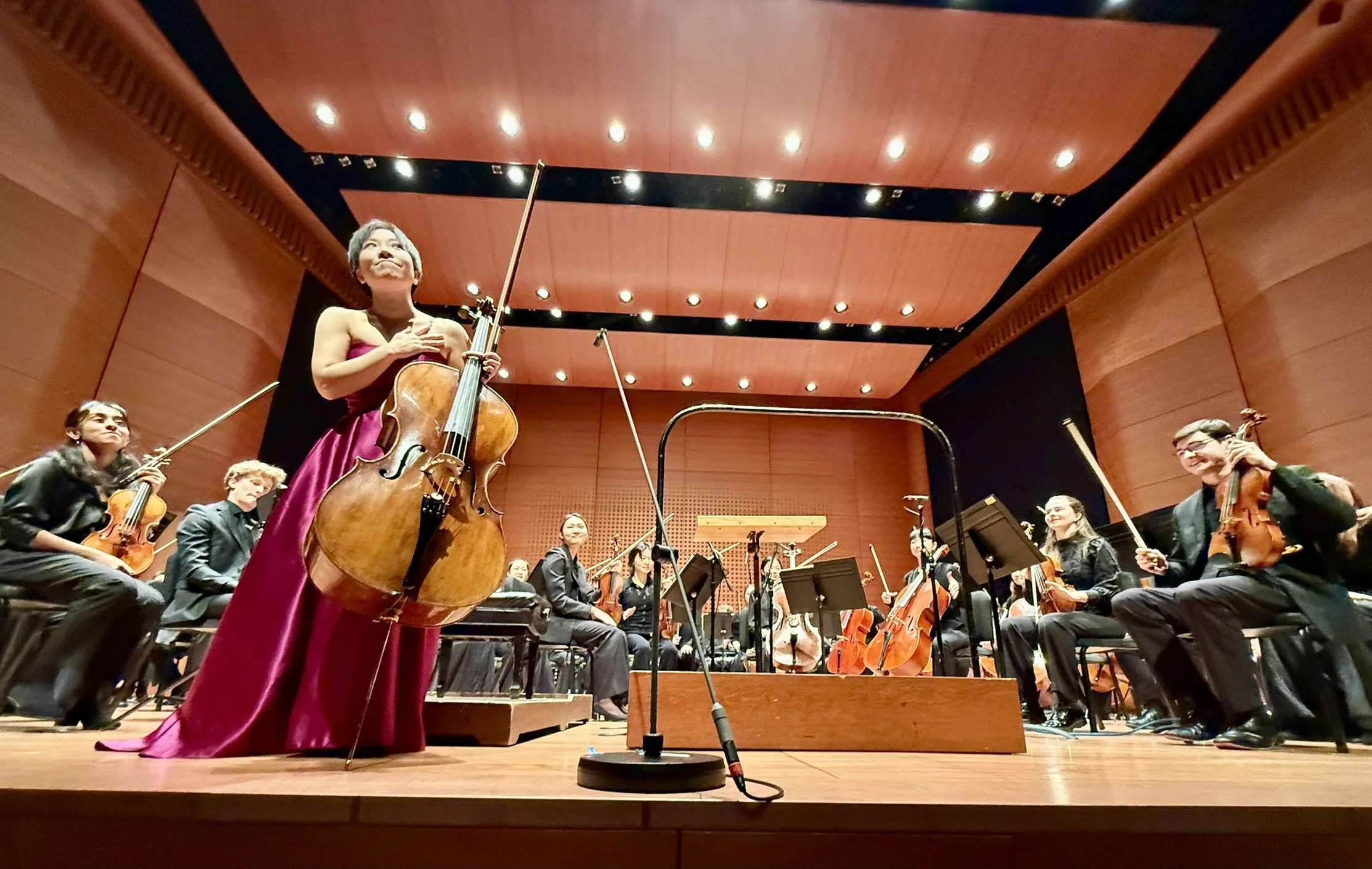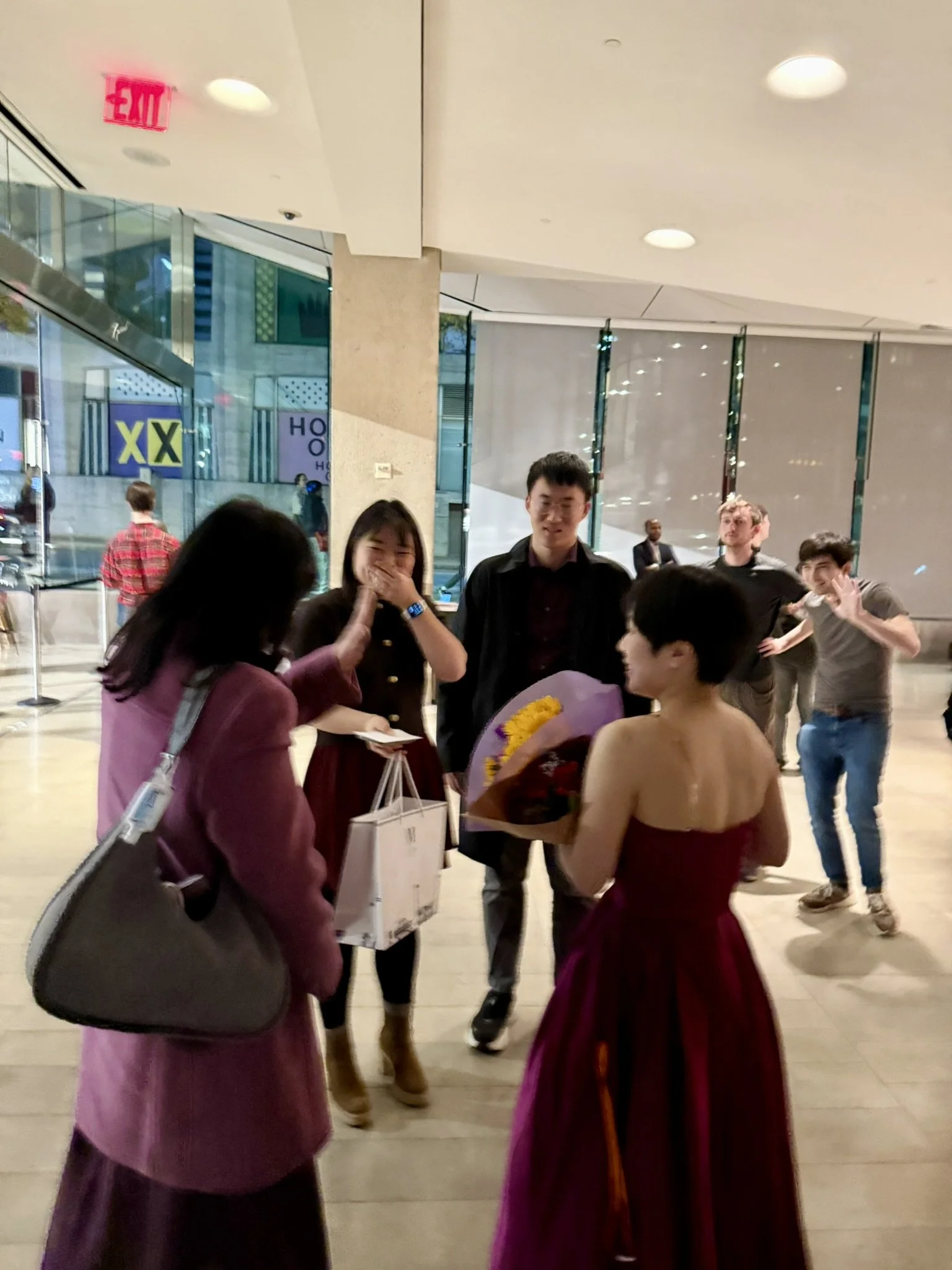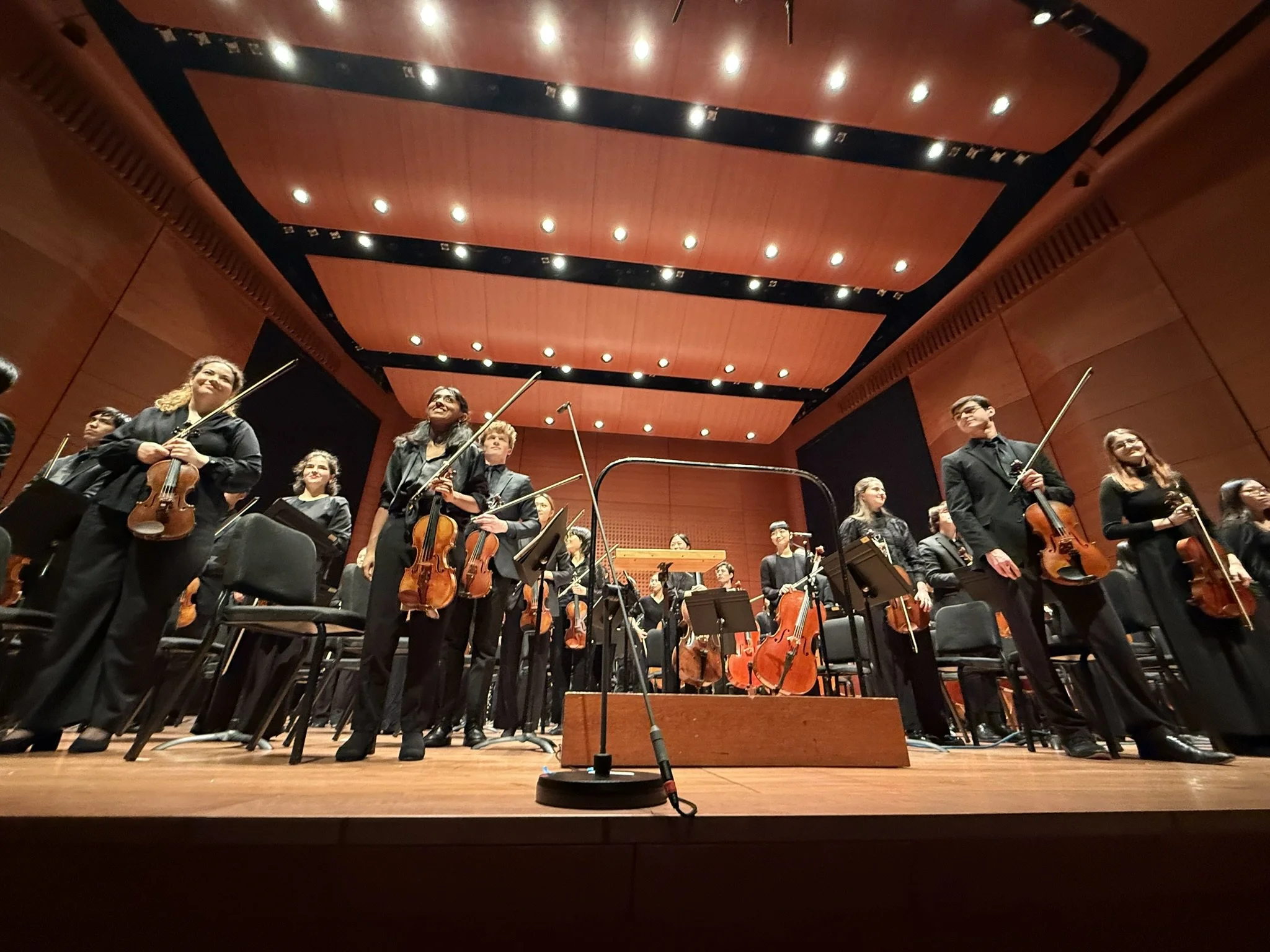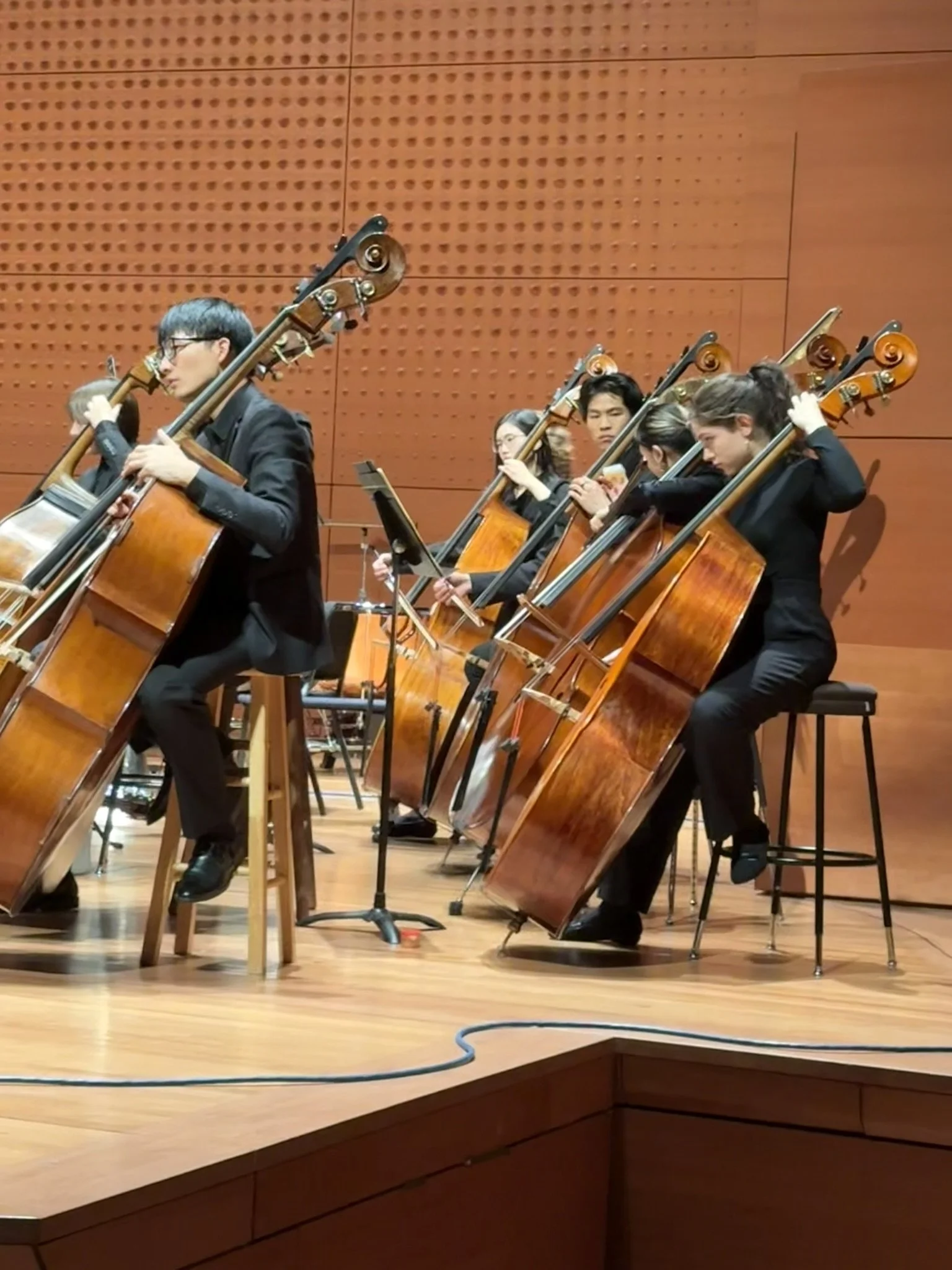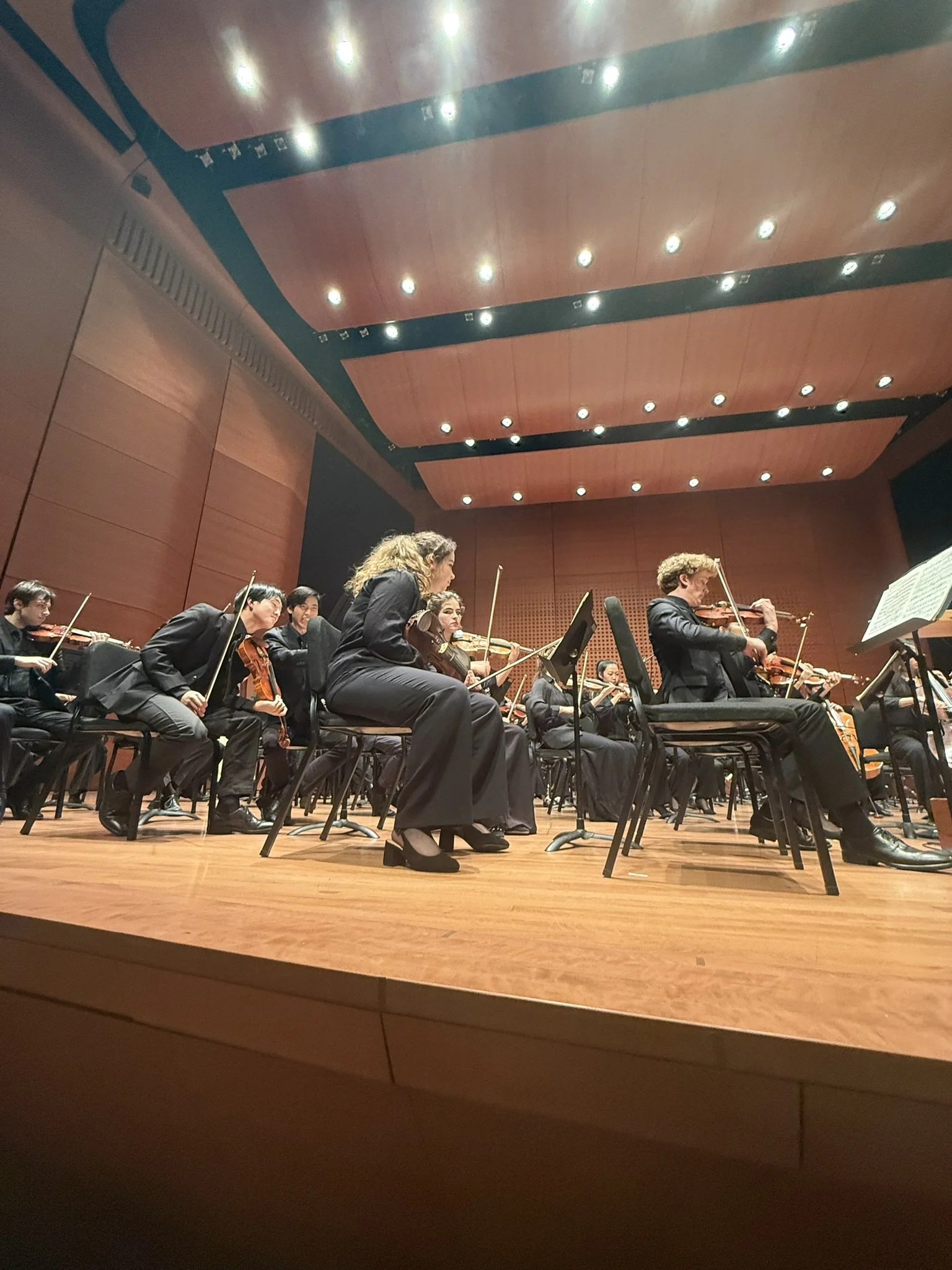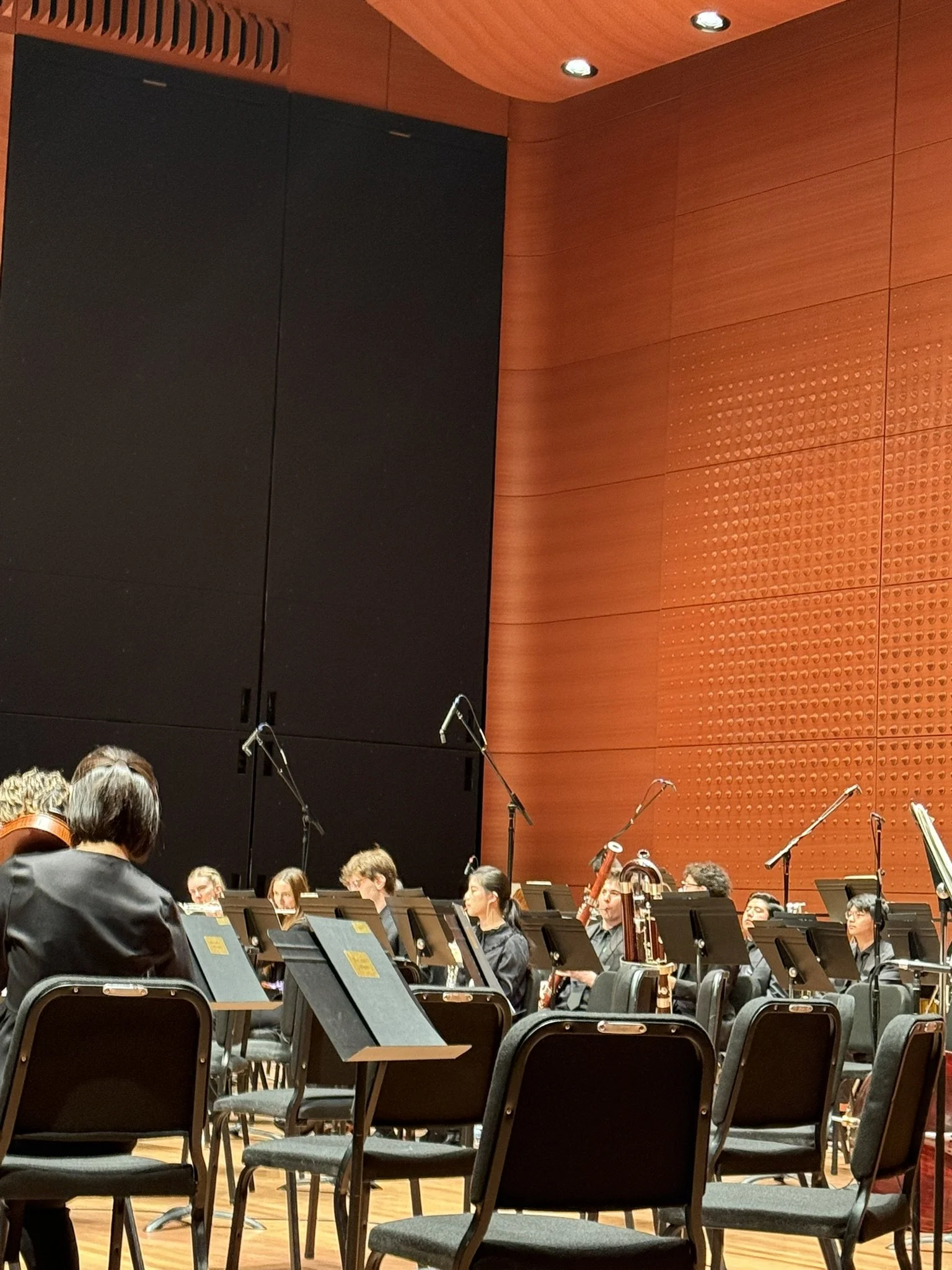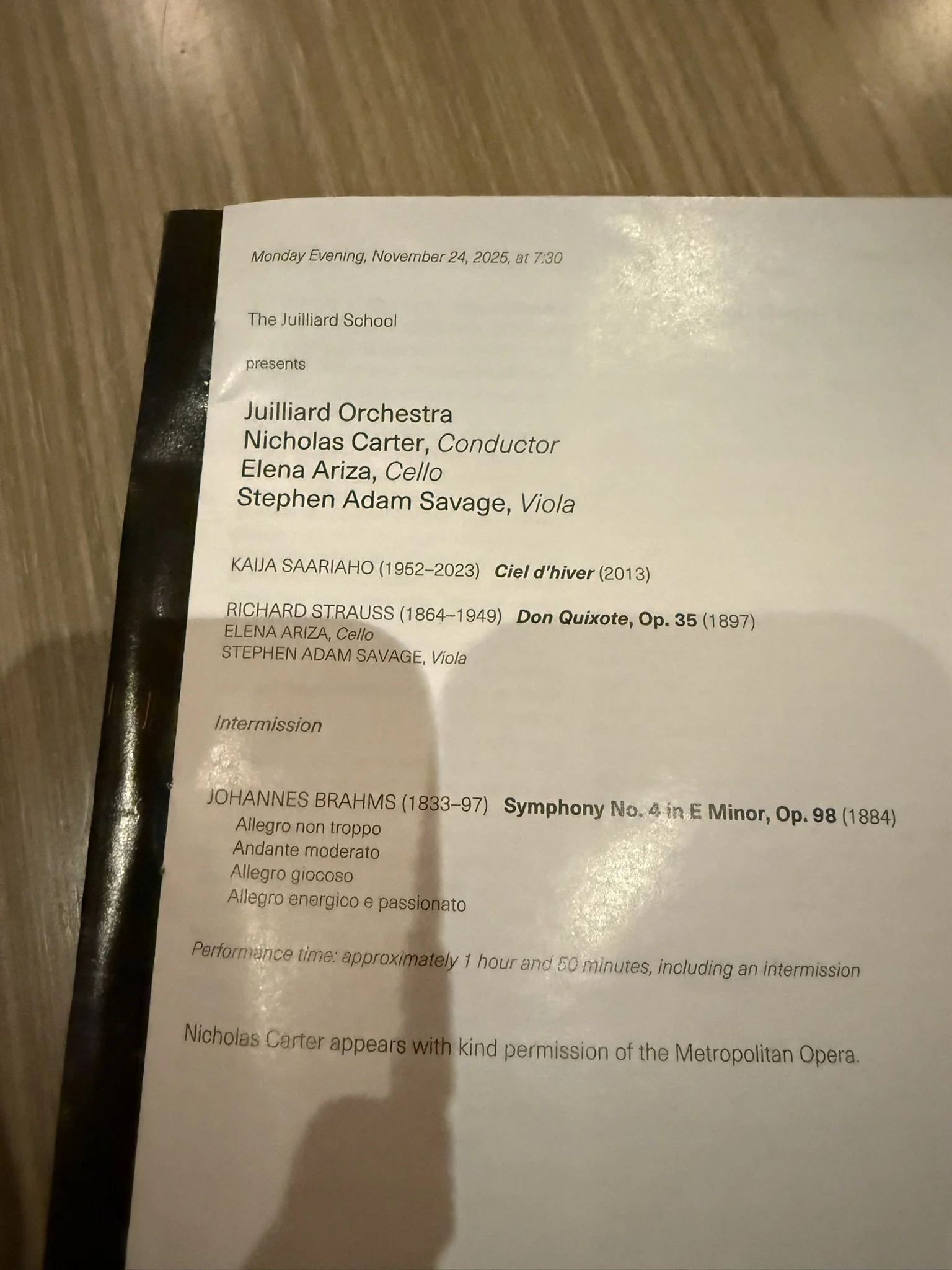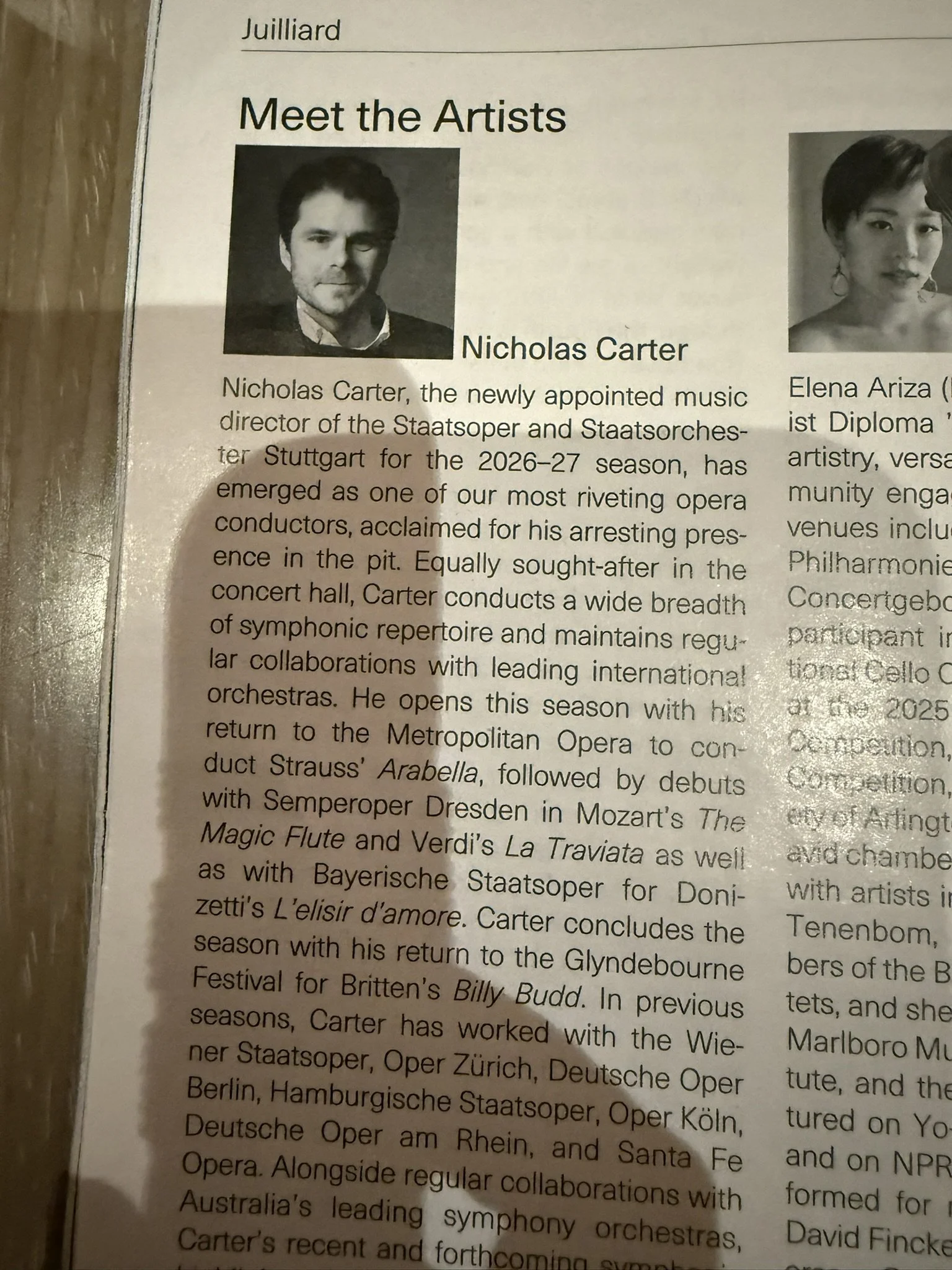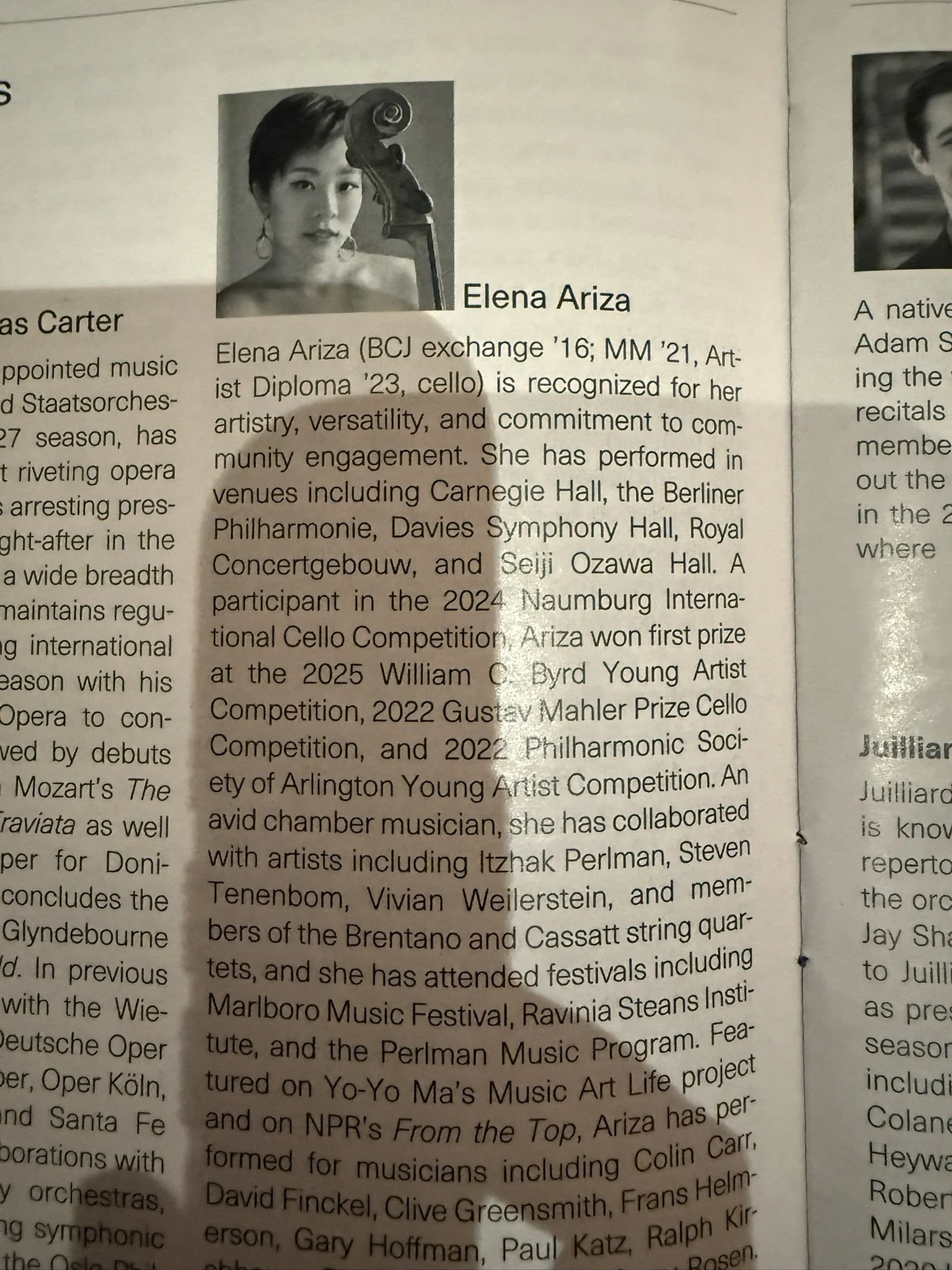Juilliard Orchestra at Alice Tully on 11. 24, 2025 began with Kaija Saariaho's (1952) Ciel d’hiver, Winter Sky (2002). Solo piccolo, violin, clarinet, oboe, and trumpet played an eerie melody from the orchestra's undulating spectral harmonics. The orchestra in the background created a gradation of undulations reminiscent of cosmic chaos, with timbral shifts that were neither tonal nor atonal, evoking microtonality. A single sound was born, transformed, and then faded away. The orchestra intertwined, sharing harmonics, drifting through a universe of flickering tones of light and shadow. Nicholas's conducting was precise, and the ensemble clear. The musicians paid meticulous attention to key shifts and harmonic changes, vividly portraying this eerie yet beautiful cosmic space, including the interplay between the principal cello and viola.
The shifts in overtones and timbre continued in Strauss's Don Quixote, composed in 1897, which consists of an introduction, a theme, ten variations, and a finale. Cervantes' Don Quixote depicts the madness of a man who, faced with the realities of life, loses the pursuit of his ideals and dreams. It teaches that it is essential for humans to have the imagination to envision how things should be, rather than being trapped by rigid reality, and that living in reality is dangerous and unhealthy. Strauss uses music to depict the illusion of windmills as giants and toy horses as flying creatures, with the strings' trills sounding like wind and the brass instruments' fluttering like bleating sheep.
When solo cellist Elena Ariza came to the stage, the orchestra and audience erupted in excitement. After a six-minute introduction, her solo begins, in variations four and five, where she mistakes a kidnapped lady and charges forward, slamming, and then the bass continues. Elena then immerses herself in her thoughts of an imaginary lover. Strauss was singing. It sounded like Waldner's singing in Arabella. She was completely Don Quixote, her bow strokes flawless, her lyrical and passionate singing conveyed directly. The Juilliard Orchestra exquisitely combined the solos of viola and violin with the soft tones of the woodwinds and tuba, creating a sound that overlapped with Strauss's chords and Saariaho's spectrum. Their focus flew by, right up to the final, quiet recollection and death glissando. Brahms' Symphony No. 4 also flew by. The sound was hoarse in the second half of the fourth movement. Nicholas maintained tension and tempo. The orchestra gave it their all. I feel these days that students' fighting spirit has become gentler than it used to be. I sometimes sensed their murderous intent 10 years ago, and the play was thrilling. These days, the performances are beautiful, but there are a few that rip into your heart, that make you feel like you're being seen through, that take away your soul. Nicholas's conduct ignites their madness.
Juilliard Orchestra Conducted by Nicholas Carter
Monday, Nov 24, 2025, 7:30PM
Alice Tully Hall
Juilliard Orchestra
Nicholas Carter, Conductor
Elena Ariza, Cello
Stephen Adam Savage, Viola
Program
SAARIAHO Ciel d’hiver
STRAUSS Don Quixote
BRAHMS Symphony No. 4
ジュリアードオーケストラのコンサートを11.24.2025アリスタリーで聴いた。カイヤ・サーリアホ(1952)の冬の空(2002)から始まった。オーケストラのスペクトラム倍音のうねりからソロのピッコロ、ヴァイオリン、クラリネット、オーボエ、トランペットなどが不気味な旋律を奏でる。背後でオーケストラが宇宙のカオスのようにうねるグラデーションを描き、調性でも無調でもない音色の変化はマイクロトーンを思わせる。一つの音が生まれ、変質し、消えていく。オーケストラは倍音を共有しながら絡み合い、光と影が揺らぐ音色の宇宙を漂う。ニコラスの指揮は的確で、アンサンブルは明晰。奏者たちはキーのシフトや倍音の変化に細心の注意を払い、首席のチェロやビオラの掛け合いも含め、この不気味で美しい宇宙空間を鮮やかに描き出していた。
倍音や音色の変化は、シュトラウスの《ドン・キホーテ》にも通じる。シュトラウスの交響詩は1897年に作曲され、序奏と主題、10の変奏と終曲から成る。セルバンテスのドン・キホーテは、人生の現実を見て理想や夢を追い求めなくなる狂気を描いた。堅苦しい現実に陥らず、あるべき姿を思い描く想像力を持つことが、人間に不可欠であり、現実を生きることはむしろ危険で不健全であると説く。風車を巨人に、おもちゃの馬を空を飛ぶものとして錯覚する様子をシュトラウスはを音楽で描写し、弦楽器のトリルは風、金管楽器のフラッタータンギングは羊の鳴き声のように聴こえる。
ソロチェロのElena Ariza がステージに登場すると、オーケストラと客席の気迫が一層高まった。6分にわたる序奏の後、彼女のソロが始まり、特に変奏4から5にかけて殉教者の聖像を誘拐された貴婦人と勘違いし突進し、叩きつけられ低音が続く。そのまま、架空の恋人への想いにふける。シュトラウスの歌が聴こえた。アラベラのウォルターの歌の様だった。彼女はドン・キホーテに徹しており、弓のストロークに迷いがなく、リリカルで情熱的な歌がまっすぐ聴き手に伝わる。オーケストラの演奏も卓越しており、ジュリアードオケはエレナやビオラ、バイオリンのソロと、木管やチューバの柔らかな響きを絶妙に組み合わせ、シュトラウスの和音とサーリアホのスペクトラムが重なった音響を生み出していた。最後の静かな回想と死のグリッサンドまで、演奏時間はあっという間だった。ブラームス交響曲4番もあっという間だった。4楽章の後半は音が枯れていた。ニコラスは多分テンションもテンポも落ちなかった。だからオーケストラは出し切っていた。例えば10年前に比べて学生の闘争精神が優しくなった気がする。昔は殺気を感じることがあった。そして、演奏もぞくぞくした。最近は奇麗だが、胸をえぐられるような、自分を見透かされるような、魂を抜かれるような演奏は少ない。ニコラスの指揮は淡々と彼らの狂気に火をつけるような指揮だ。

